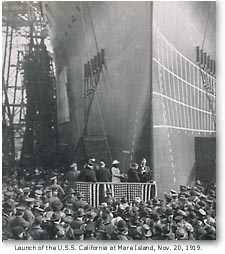|
||||
|
||||
|
|||||||||||||||||||
Where the Pacific Fleet Is Maintained
 Mare Island, Vallejo, is Uncle Sam’s principal seat of Pacific Coast defense. Here, in the West’s first and greatest U.S. Navy Yard, lies the task of maintaining the Pacific fleet at topmost efficiency, and the additional job of building new warships as the American defense program increases. Mare Island, Vallejo, Navy Yard is the largest single industrial plant west of the Mississippi, representing nearly $100,000,000 investment. Mare Island, Vallejo, is Uncle Sam’s principal seat of Pacific Coast defense. Here, in the West’s first and greatest U.S. Navy Yard, lies the task of maintaining the Pacific fleet at topmost efficiency, and the additional job of building new warships as the American defense program increases. Mare Island, Vallejo, Navy Yard is the largest single industrial plant west of the Mississippi, representing nearly $100,000,000 investment.
Historically, Mare Island has a romantic background. The name, like that of the city within whose boundaries it lies, is traceable to Gen. Mariano Guadalupe Vallejo, who originally received the grant of the eastern Sonoma Valley and the foothills adjoining Carquinez Strait, as a reward for his successful defeat of the Indian tribes. General Vallejo’s name was given to the young community in 1852 by the legislature, which in that year made Vallejo the state’s capital. But when the General was unable to make good his promise of $350,000 in gold if Vallejo was made the state capital, the legislature moved on to Sacramento. General Vallejo was a great horse fancier. He particularly prized one beautiful white mare. On an occasion when a number of the General’s horses were being ferried across the Strait from the Contra Costa shore to Benicia, the crude barge capsized. Some of the horses swam ashore, others drowned, and the white mare disappeared. It is recorded that many weeks afterward, the white mare was discovered grazing on the hillside of the island across the channel from Vallejo. From that day, the island was known as “Mare’s Island,” shortened to Mare Island.
In 1854, Commodore David G. Farragut was sent to California to establish and to take charge as first commandant of Mare Island Navy Yard. From Commodore Farragut down to the present commandant, Rear Admiral David W. Bagley, the navy men in charge of the great shipbuilding plant have striven to build the most efficient naval service institution in the nation. The first ships to glide down the primitive ways were massive structures of timber, far different from the welded steel floating fortresses that line the seawall today. The original drydock was a cumbersome floating affair, built in New York, knocked down, and reassembled at the yard following a long journey around Cape Horn. The second drydock, which took nineteen years to build and which was completed in 1891, was 508 feet long and rests on a rock foundation of cut granite blocks. A third drydock, 740 feet long, was completed in 1910, after eleven years of construction work. Both these docks still serve the yard, used for overhaul and repair work.
Mare Island holds the record for speed in construction of naval vessels, having earned the distinction in 1917, when the destroyer U.S.S. Ward was only seventeen days from keel- Greatest single accomplishment of Mare Island, Vallejo, Navy Yard, was the construction of the U.S.S. California, now flagship of the battle force and one of our largest battleships. Another and larger battleship was begun on September 1, 1920, when the keel of the U.S.S. Montana was laid, but due to the provisions of the armaments pact, the Montana was scrapped when only 27 per cent completed. Mare Island’s first ship was the frigate U.S.S. Saginaw, launched more than 75 years ago. Since then nearly 100 fighting ships have slid down Mare Island ways. In addition to the job of keeping the fleet in repair, Mare Island is the principal fleet supply base for the Pacific Coast. Approximately 6,000 men are employed at Mare Island in the construction and repair of ships. Under the new naval building program, Mare Island has been allotted one submarine each year for the next decade. In addition, there will be allotted to Mare Island one submarine tender or other auxiliary craft every year until 1948. CALIFORNIA—Magazine of the Pacific |